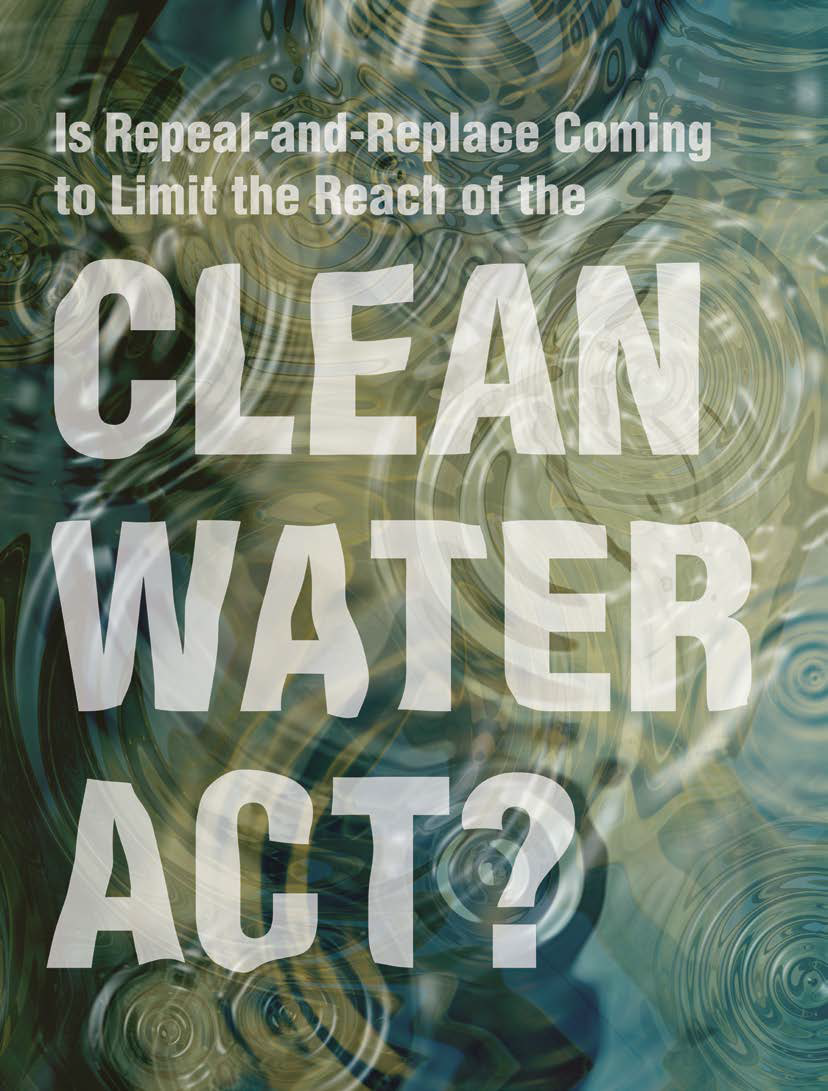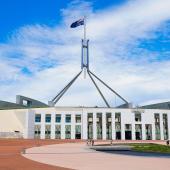
CHEAT SHEET
- Defect to define. The definition of the 2015 “waters of the United States” rule establishes the scope of authority under the US Clean Water Act.
- Kennedy’s opinion. In Rapanos v. United States, US Supreme Court Justice Anthony Kennedy established that non-negative-in-fact waters could be regulated if there was a significant nexus between those waters and a traditionally navigable waterway.
- The order. US President Donald Trump issued an executive order declaring that the Clean Water Act was “one of the worst examples of federal regulation” — instructing that agencies interpret the term “navigable waters” in a manner consistent with the opinion of the late Supreme Court Justice Antonin Scalia in Rapanos v. United States.
- The proposition. The proposed repeal-and-replace rule would recodify the regulatory text that was in place prior to the Clean Water Act, while noting that repealing the 2015 rule would leave a definition of “waters of the United States” that is consistent with the Supreme Court decisions.
“Repeal and replace” is not limited to the congressional debate on healthcare. While it does not enjoy the same impassioned debate, the waters of the United States Rule under the Clean Water Act (CWA), and the jurisdiction of the Environmental Protection Agency (EPA) and Army Corps of Engineers, is up for substantive change. And like the political confrontations over the Affordable Care Act, there is not much clarity on what a redefined “waters of the United States” might look like. The only certainty is that the decisions of the Obama administration will likely soon disappear.
For a practitioner in the environmental law field, the lack of clarity in the definition of waters of the United States has caused much debate and uncertainty. Predicting how that debate will play out in the future is difficult because even past court decisions are inconsistent and murky. But if you have any stake in CWA issues, it is imperative to understand the issues and possible outcomes.
For a practitioner in the environmental law field, the lack of clarity in the definition of waters of the United States has caused much debate and uncertainty. Predicting how that debate will play out in the future is difficult because even past court decisions are inconsistent and murky.
The US Environmental Protection Agency and the US Army Corps of Engineers recently announced that they would propose to pursue that strategy in yet another twist in the fate of the 2015 “Clean Water Rule” that had redefined “waters of the United States.” That definition establishes the scope of authority under the federal Clean Water Act. The rule, borne of US Supreme Court decisions and multiple attempts to craft a definition consistent with the Court’s rulings, has been intensely litigated by environmental groups and industry. Additional confusion for the regulated community and regulators came from US President Donald Trump’s February 2017 executive order that signaled the administration’s opposition to the rule.1 Now, the agencies are employing a two-step approach that would first repeal the rule by rescinding the 2015 definition of “waters of the United States” in the code of federal regulations, and then pursue the more difficult notice-and-comment rulemaking period to develop a new definition.
1 President Trump’s executive order, “Restoring the Rule of Law, Federalism, and Economic Growth by Reviewing the ‘Waters of the United States’ Rule.” (February 2017).
According to the agencies, “[t]his action would, when finalized, provide certainty in the interim, pending a second rulemaking in which the agencies will engage in a substantive re-evaluation of the definition of ‘waters of the United States.’ The proposed rule would be implemented in accordance with Supreme Court decisions, agency guidance, and longstanding practice.” It is unclear how much certainty can be provided in the interim. Relevant Supreme Court decisions have not provided clear direction as to the scope of the CWA. The issue is the guidance for the agencies, and the lack of a consistent rule that makes it difficult to define “longstanding practice.” That lack of clarity is reflected in various interpretations of the CWA and rulings in lower court decisions, and was the genesis for the rule in the first place.
The CWA provides federal authority to regulate “navigable waters.” The term “navigable waters” is defined in the statute as “waters of the United States.” However, “waters of the United States” is not defined in the statute, and has been the subject of a triad of US Supreme Court decisions establishing the federal government’s scope of authority to regulate under the CWA.
From the enactment of the CWA in 1972 through 2001, courts, including the Supreme Court in United States v. Riverside Bayview, 474 US 121 (1985), tended to support broad authority under the statute. It ruled that the powers of the agencies extended to the reaches of the federal government’s authority under the Constitution’s Commerce Clause. That expansive view was curtailed by the Supreme Court in Solid Waste Agency of Northern Cook County v. Army Corps of Engineers (SWANCC), 531 US 159 (2001). In SWANCC, the court struck down the government’s interpretation that its CWA jurisdiction extended to non-navigable-in-fact intrastate ponds that supported migratory bird populations.
The court continued its contraction of the agencies’ authority under the CWA in Rapanos v. United States, 547 US 715 (2006). An ideologically fragmented 4-4-1 plurality decision authored by the late Justice Antonin Scalia took a very narrow view of the breadth of the CWA. That plurality held that federal jurisdiction could extend over non-navigable waters only if those waters exhibit a relatively permanent flow or, in the case of wetlands, where there is a continuous surface water connection between the wetland and a relatively permanent waterbody. The four-justice dissent, authored by Justice Paul Stevens, took a much broader, pre-SWANCC view of jurisdiction.
However, it was Justice Anthony Kennedy’s concurring opinion that won the day. It established that non-navigable-in-fact waters could be regulated if there was a “significant nexus” between those waters and a traditionally navigable waterway. The majority of lower courts have viewed Justice Kennedy’s concurrence in Rapanos as controlling law, following the test established by the court in Marks v. United States, 430 US 188, 193 (1977), in which the court provided that in plurality decisions, “the holding of the court may be viewed as that position taken by those members who concurred in the judgments on the narrowest grounds.”
Most federal district and circuit courts considering the scope of CWA jurisdiction have concluded that Justice Kennedy’s significant nexus test fits that description. It was noteworthy that Chief Justice John Roberts, in his concurrence in Rapanos (after also signing on to Justice Scalia’s opinion), admonished the EPA and the Army Corps of Engineers, noting that the agencies had been repeatedly warned to clarify and revise the regulatory definition of “waters of the United States,” and by failing to do so meant living with the court’s ruling.
Subsequent to Rapanos, and after numerous false starts, the agencies revised the regulation in 2015 after a lengthy rulemaking process that garnered more than one million public comments. The rule is based on the “significant nexus” test, which more broadly defines the scope of water bodies that are subject to the CWA, rather than the test in the Scalia plurality. It provides specific guidance with respect to riparian areas, floodplains, and tributaries.
Not surprisingly, there was significant opposition to the rule from states, industries, and environmental groups. More than two dozen lawsuits challenging the rule were filed in federal district and circuit courts. Apart from the substantive challenges to the rule, a significant issue surfaced as to whether the challenges needed to be filed first in federal district court or circuit court.
In the midst of that controversy, the circuit court cases were consolidated in the Sixth US Circuit Court of Appeals, and that court stayed the rule before deciding whether it had jurisdiction to hear the direct challenge. The Sixth Circuit held that federal appellate courts retained jurisdiction over the controversy, holding that the CWA “authorizes direct circuit court review not only of actions issuing or denying particular permits, but also regulations governing the issuance of permits.” However, in the waning days of the Obama administration, the Supreme Court agreed to resolve the jurisdictional dispute. Pending a decision by the court, the Sixth Circuit’s stay remains in place.
Shortly after the court’s grant of certiorari to hear the jurisdictional question, President Trump issued his executive order. The order refers to the 2015 rule as “one of the worst examples of federal regulation” and instructed the agencies to interpret the term “navigable waters” in a manner “consistent with the opinion of the late Justice Antonin Scalia in Rapanos v. United States…”
In the proposed repeal-and-replace rule, the agencies state, on the one hand, that the “proposed rule would recodify the identical regulatory text that was in place prior to the 2015 Clean Water Rule and that is currently in place as a result of the US Court of Appeals for the Sixth Circuit’s stay of the 2015 rule,” but, at the same time, note that repealing the 2015 rule will leave the former definition of “waters of the United States” that is consistent with the Supreme Court decisions. In view of that statement, and the reference in the executive order to the Scalia opinion, it is likely that the agencies, while following the text of the pre-2015 definition, will interpret it such that “waters of the United States” will be consistent with a narrower view.
With the fate of the final rule unknown, the regulated community remains in a state of suspended animation as it awaits the agencies’ two-step rulemaking process. The Supreme Court’s pending decision on the jurisdictional question may provide guidance as to which lower court has jurisdiction over the substantive challenges to the rule. Yet, even if the jurisdictional question is resolved by the high court, any judgment on the merits may be mooted by “Step 1” of the proposed rule, which, if promulgated, would rescind the 2015 definition.
Nevertheless, any new rule replacing the definition (“Step 2” of the proposed regulation) will likely be challenged on two fronts. First, a substantive legal challenge would focus on whether the applicable law following Rapanos is Justice Scalia’s plurality opinion or Justice Kennedy’s “significant nexus” concurrence. Second, if any aspect of the regulation is revised in a way that could be viewed as retracting federal authority, then such revision will be challenged under APA Section 706(2) (A), which states that the “reviewing court shall … set aside agency action … found to be arbitrary, capricious, an abuse of discretion, or otherwise not in accordance with law.”
When the dust settles, there is little doubt that any new rule that redefines “waters of the United States” will be heavily litigated.
When the dust settles, there is little doubt that any new rule that redefines “waters of the United States” will be heavily litigated. While industry and some states fought the 2015 rule because they believed it went too far, environmentalists will certainly fight the agencies’ repeal and replace efforts as not going far enough to protect the environment. Although the outcome for the “waters of the United States” remains murky, one thing remains clear: Diametrically opposed factions will litigate this issue and the Supreme Court will once again be charged with determining the scope of the CWA and the boundaries of waters of the United States. If recent history is any guide, any Supreme Court decision will likely not be the final word.
Potential impact of changes to the Clean Water Act
The prospective change in the definition of waters of the United States would have a significant impact on what waters, or water features, may be regulated under the Clean Water Act. The following example illustrates potentially different outcomes.
FACTUAL SCENARIO
- River A is a traditionally navigable water subject to the Clean Water Act under any of the regulatory definitions or case law interpretations of “waters of the United States.”
- Wetland B is 400 feet from River A but separated by a dirt road. There is no continuous surface water connection between the two, although during rain events water flows from Wetland B over the road into River A. There is a continuous subsurface hydrological connection between Wetland B and River A.
- An ephemeral, intermittent Stream C flows into Wetland B, is located less than 1,500 feet from the high water mark of River A, and is within the same floodplain as River A. The flow is not continuous, and flows only during periods of heavy rain. Stream C has a bed, bank, and ordinary high water mark.
- There are prairie potholes that are proximate to Stream C.
- Wetland B acts to filter pollutants and nutrients from Stream C and the prairie potholes before those pollutants and nutrients reach River A.
OUTCOME ONE: LACK OF JURISDICTION UNDER THE SCALIA PLURALITY
Neither Wetland B, Stream C, nor the prairie potholes would likely meet the jurisdictional test under the Scalia plurality standard set forth in Rapanos and referenced in the Trump executive order, primarily because there is no continuous surface connection between those waters/ features and River A.
OUTCOME TWO: JURISDICTION UNDER THE 2015 RULE
Under the 2015 waters of the United States Rule, it is likely that Wetland B and Stream C would be jurisdictional under the Clean Water Act, and the prairie potholes may be jurisdictional subject to further assessment. Under the rule (and presumably under Justice Kennedy’s test from Rapanos) there would be significant nexus among the various water bodies and features to River A. They would meet the definitions of both significant nexus and adjacency/neighboring because:
- Wetland B, although arguably “isolated,” would be jurisdictional under the Riverside Bayview standard, and would meet both the Kennedy view of “significant nexus” (affecting the chemical, physical, and biological integrity of a navigable water”) and the 2015 rule definition (affects the navigable water by, among other things, sediment trapping and nutrient recycling).
- Stream C meets the physical criteria of a “tributary” under the 2015 rule, is within the boundaries established by the rule to determine whether it is “neighboring” with the navigable water, and would likely satisfy the significant nexus test — it contributes flow to River A through Wetland B, and affects that navigable water.
- Whether the prairie potholes have a “significant nexus” to River A, or are neighboring, would likely require a more detailed assessment of the relationship between those features and the navigable water under the 2015 rule.






